By Nathan N. Prefer
On September 16, 1944, Adolf Hitler revealed his master plan for reversing Germany’s declining fortunes in the West during World War II. At a routine meeting with leading members of his military staff, including the head of his Armed Forces Command, General Wilhelm Keitel, and the chief of his planning staff, General Alfred Jodl, the Fuehrer pointed to a map of the Ardennes Forest in Belgium and announced, “I have just made a momentous decision. I shall go over to the counterattack, that is to say, here, out of the Ardennes, with the objective—Antwerp.”
His staff stood in shocked surprise. After all that had happened to Germany in recent months, the defeat in Normandy, withdrawal from Southern France, retreating to the Westwall, Germany’s last line of defense, withdrawal to northern Italy, and the series of defeats in the East, how was it possible for Germany to now suddenly turn and strike at its attackers? But Hitler knew that Germany’s industry was still productive despite Allied bombing and that German morale was not only good, but improving as the Allies moved closer to the German heartland.
Armed with deceptive figures provided to him by his various sycophants, Hitler was convinced that his plan had merit. And it had worked before, in 1914 and again 1940, so why shouldn’t it now? General Jodl immediately set out to develop the plan.
Most of the German military leaders felt the plan was far too ambitious. Alternatives were offered but quickly dismissed. The plan required the withdrawal of numerous divisions from active fronts to form the attack force. Thirty divisions and 1,500 aircraft, including some of the new jet planes, were promised. No allowance was made for an Allied response once the attack began. There were questions about the availability of resources, fuel, ammunition, equipment, for such a major undertaking. And the plan made no mention of what was to happen when, or if, the attack did in fact reach its ultimate goal, the Belgian port of Antwerp.
The officer selected to command the operation, Field Marshal Walther Model, remarked, “This damned thing hasn’t a leg to stand on.” But the order stood, and the generals began to do what they could to make it work. The attack date, postponed several times for various reasons, was now set for December 16, 1944.
Across the front line, the Americans were busy with their own plans for an offensive. General Omar N. Bradley, commander of 12th Army Group, was in fact preparing two attacks, one to the north of the Ardennes by his First U. S. Army, and a second south of the Ardennes by the Third U. S. Army. To man these offensives, he had deliberately left his center force, Major General Troy H. Middleton’s VIII Corps, weak and stretched along a wide front covering the Ardennes. The risk was accepted, and even called a “calculated risk” by the Allied Supreme Commander, General Dwight D. Eisenhower.
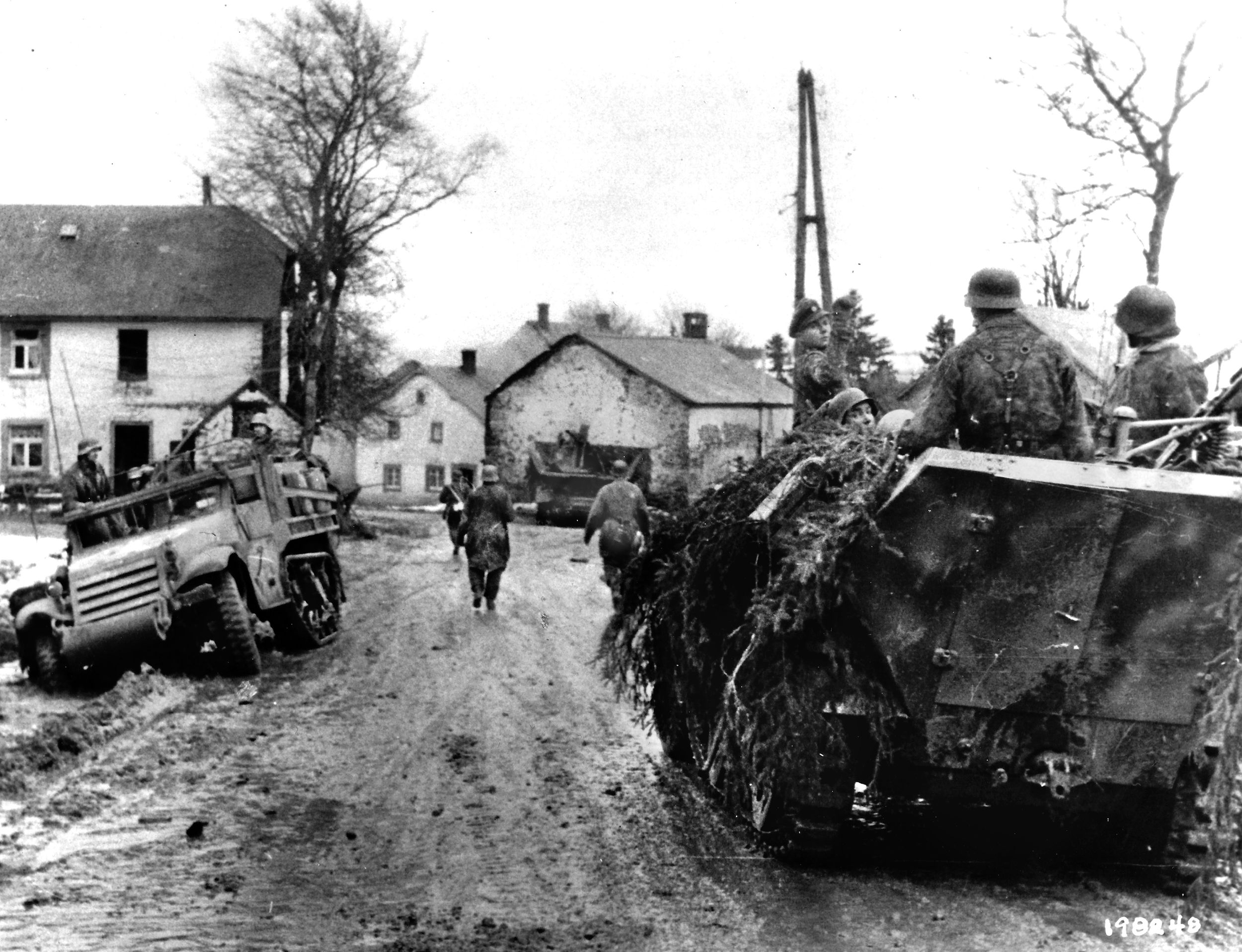
The Allies were convinced that Germany was all but defeated and that these new offensives would bring them into the heart of Germany to ensure that defeat. Not that there weren’t some warning voices when senior intelligence officers raised questions about the whereabouts of German reserves, and why captured prisoners’ morale was still so high. But these few voices were largely ignored.
Not only was the American Ardennes front stretched thin, but the forces defending that front were themselves weak in one manner or another. Defending the critical Losheim Gap, through which the Germans under General Erwin Rommel had attacked in 1940, was only one cavalry squadron armed with light tanks and armored cars. There was the untested 106th Infantry Division, many of its soldiers still wearing ties! This division alone was defending 20 miles of front line. Another relatively new division, the 99th, manned another sector of this line. They would benefit, however, from the presence of the veteran 2nd Infantry Division preparing to launch General Bradley’s northern attack.
To the south stood two veteran infantry divisions, the 4th and 28th. Both had been fighting since Normandy, and both were there to rest and recuperate after costly and debilitating campaigns. In all, about 200,000 Germans were about to strike about 83,000 American troops holding a “quiet sector.”
On the night of December 14, a civilian woman came into the lines of the 28th Infantry Division to report that the woods near Bitburg were jammed with hidden German equipment. Questioned by the division intelligence officer, her responses were so authentic that she was sent up to the VIII Corps headquarters for further interrogation. Again, she was believed and sent further up the chain of command to First Army headquarters, but by the time she arrived her story was being verified by German troops attacking out of the foggy night and snow of the Ardennes.
Both the 4th Infantry Division (Major General Raymond O. Barton) and the 28th Infantry Division (Major General Norman D. Cota) had recently distinguished themselves in the bloody battles of the Hürtgen Forest and were now training replacements for the 9,000 casualties they had suffered in those battles. The 28th Infantry Division in particular had suffered greatly in that forest, losing 6,184 casualties, more than the authorized rifleman strength of an American infantry division at the time.
One of every three officers had become a casualty in the forest. Here the division earned its nickname of the “Bloody Bucket” from its red keystone shoulder patch and the heavy casualties it had suffered. Since November 22, it had defended a line 25 miles long along the Luxembourg-German border. With such a long front to cover, the division had no choice but to resort to establishing individual strongpoints, mostly in local villages. Even then, things were made more difficult when one battalion was held in reserve. The division was aligned from north to south with the 112th Infantry Regiment (Colonel Gustin M. Nelson) to the north, the 110th Infantry (Colonel Hurley E. Fuller) in the center, and the 109th Infantry Regiment (Lieutenant Colonel James E. Rudder) on the south of the division’s front.
The German force about to strike the “Bloody Bucket” was General Heinrich Luettwitz’s XLVII Panzer Corps. Its mission was to cross the Our and Clerf Rivers, make a dash “over Bastogne,” get to the Meuse River, force a crossing near Namur, and then strike for Brussels and Antwerp. Speed was essential, and flank protection was to be ignored. The Seventh Army would protect his southern flank and other German forces would be advancing to the north. He knew from intelligence reports he would be facing the 28th Infantry Division and that it was covering a wide front and was strung out. He also knew of its heavy losses in the Hürtgen Forest. With this information, General Luettwitz was not concerned about getting across the rivers; his main concern was how to best employ his armor over the narrow, twisting roads in his sector once he did.
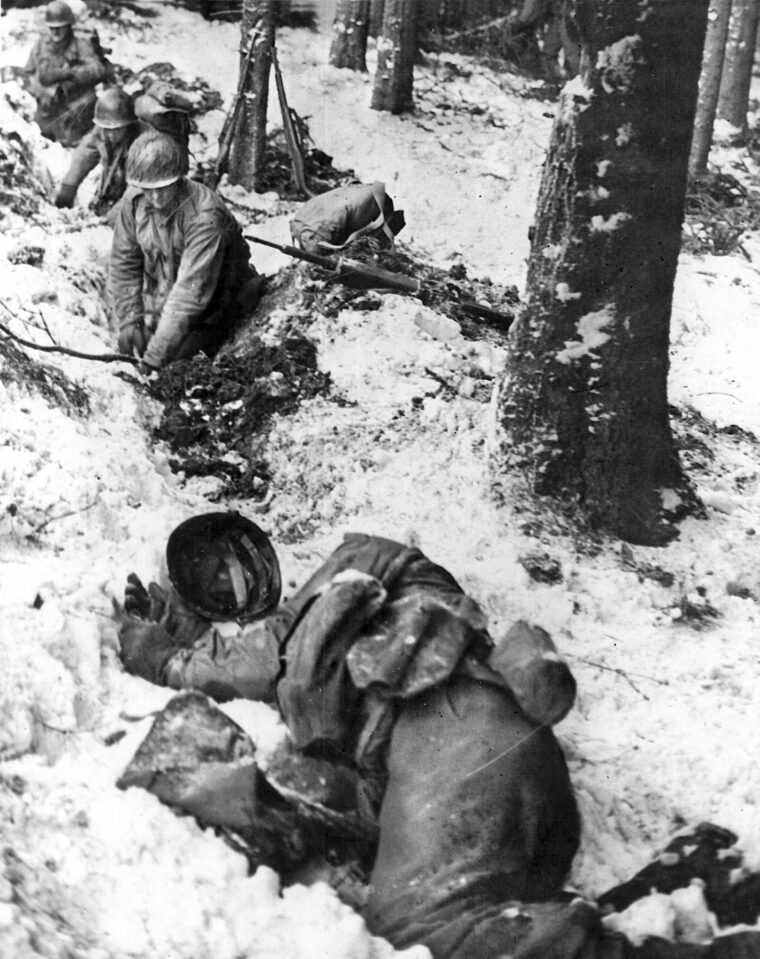
That armor was included in the three divisions of the XLVII Panzer Corps. The veteran and re-equipped 26th Volksgrenadier Division (Major General Heinz Kokott), recently transferred from the Russian front. With 17,000 men, 5,000 horses and 42 antitank guns, the division was to cross the Our and Clerf rivers, hold the roads open for following armor, and then seize Bastogne, a key crossroads town in Belgium, with or without the armor support. The veteran 2nd Panzer Division (Colonel Meinrad von Lauchert), with new model Panther tanks and 48 armored assault guns, would also cross the Our River and move against Bastogne. Following that the Panzer Lehr Division (Lieutenant General Fritz Bayerlein), another veteran formation, would race to Bastogne and hold the vital crossroads town. Reinforced with armored tank destroyers and an assault gun brigade, the division was to assist the 26th Volksgrenadier Division in seizing the crossings over the rivers. In reserve General Luettwitz also had the heavily armored Fuehrer Begleit Brigade. The sector designated for the XLVII Corps breakthrough was held by the 110th Infantry Regiment, 28th Infantry Division.
Colonel Fuller’s regiment was in the center of the division front line, holding a series of villages with one or two infantry companies each along its 10-mile front. These villages were usually along a north-south highway known to the Americans as “Skyline Drive.” This ridgeline ran within a mile or two of the Our. The 2nd Battalion, 110th Regiment, was held in division reserve at Donnage.
The Our was about 40 feet wide and easily fordable, but it was the roads leading to and from it that presented a problem. They were narrow, circuitous, and steep in places, making it difficult for large vehicles or tanks. The Americans had blocked the four main roads leading into their sector with their village strongpoints, including one road that led directly to Bastogne. Although the Americans regularly patrolled across the river each night, they knew of only the presence of the 26th Volksgrenadier Division. And it was that unit which almost gave the game away.
General Kokott’s 78th Volksgrenadier Regiment was in the habit of also pushing patrols across the Our River during the night, withdrawing them at dawn. But on the evening of December 15 these patrols did not withdraw. Instead, German assault engineers continued to cross the river in rubber assault boats, soon followed by the assault companies and heavy infantry weapons. These forces then moved to their line of departure, in some cases very close to the American-held villages. The 77th Volksgrenadier Regiment followed while the 39th Volksgrenadier Regiment circled in some woods prepared to move across country to seize bridges over the Clerf River near Drauffelt. General Kokott had only the first day to cross both rivers, according to plan. To do this, the 110th Infantry would have to be quickly eliminated as a threat to his advance.
Holding the critical access to the Dasburg-Bastogne Highway was Lieutenant Colonel Donald Paul’s 1st Battalion, 110th Infantry. Company B and a platoon of the 630th Tank Destroyer Battalion held Marnach, a key access point. To the south Company C and the regimental cannon company held Munshausen, guarding a side road. Company A at Heinerscheid was on the left, but outside the immediate assault sector of the XLVII Corps. So was Company D at Grindhausen.
Major Harold F. Milton’s 3rd Battalion was on the regimental right. It had its own Company K, and Company B, 103rd Engineer Combat Battalion, at Hosingen, a village overlooking two of the four roads the Germans intended to use to capture Bastogne. Company I held a village to the south while the 110th Antitank Company held the village of Hoscheid. Both were, unknown to the Americans, on the boundary between the XLVII Corps and its neighbor, the LXXXV Corps. Company L, Company M, and the battalion headquarters company barred an approach to a Clerf River crossing at Consthum. Lieutenant Colonel Ross C. Henbest’s 2nd Battalion was west of the Clerf River near the regimental command post at the town of Clerf. None of these positions offered mutual support to any of the others.
The opening barrage began at 5:30 a.m. on December 16. Colonel Fuller lost all telephone communications with his battalions to German artillery fire, but his own artillery radios continued to function. Further, the Germans’ limited ammunition supply left their advancing infantry without immediate covering fire while they struggled across the Our River, still short of the American defenses. At 6:15 that morning, Colonel Fuller received the first word that his regiment was under attack. Company L, along Skyline Ridge at Holzthum, reported shadowy figures in the half-light of dawn. Whether they were friend or enemy, they could not tell. Colonel Fuller notified division headquarters about the possible enemy activity.
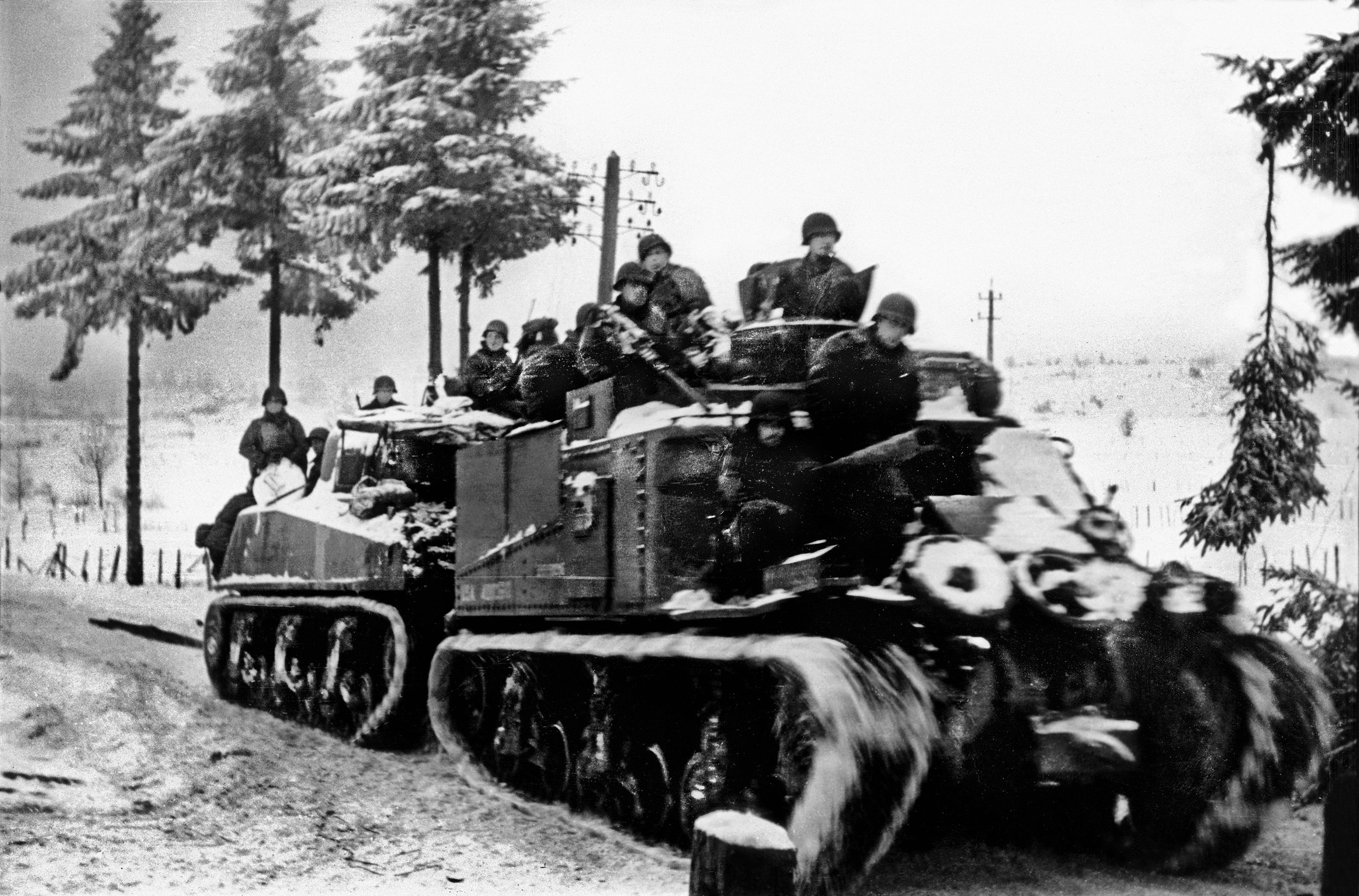
The figures seen by Company L were in fact Germans of the 39th Volksgrenadier Regiment, who had infiltrated across the Our River during the night and were moving to attack Holzthum. For the 26th Volksgrenadier Division, at least, the decision to move across the river during the hours of darkness and get into position early proved beneficial. Others were striking at Hosingen, along Skyline Drive.
Hosingen was a small village of about 550 people. It lay on Luxembourg’s main north-south highway, Skyline Drive, about four miles west of the Our River. Here Company K, 110th Infantry, was responsible for about two miles of the regimental 10-mile front line, a length normally held by a battalion. With little choice, Company K opted to defend Hosingen, thus blocking the road to the west. The defenders had no armored support, and so the company was placed with the 2nd Platoon and one heavy machine gun team from Company M holding the southern end of the town, 1st Platoon and the Weapons Platoon holding the north end of town, and 3rd Platoon with another Company M machine gun squad two miles south of town.
Company K’s 60mm mortars, reinforced with some 81mm mortars from Company M, were behind buildings in the center of town. Automatic weapons covered likely approaches to the town, while the mortars, in theory, covered dead spots. Defensive fire from supporting artillery had been plotted and registered, but an ammunition shortage restricted the use of these guns unless and until an actual enemy had been identified.
Captain Jarret’s Company B, 103rd Engineer Combat Battalion, whose mission it was to maintain the roadway, was also in Hosingen. Responsible for about 15 miles of Skyline Drive, they also maintained a secondary road that ran west of the town. The engineers were not included in the defensive arrangements for Hosingen, but the heavy and light machine guns mounted on many of their vehicles could be used in defending the village if the need arose.
About 5:30 a.m. on December 16, the observation post in the water tower above the town reported “pinpoints of light” coming from the German lines. These soon turned into enemy artillery firing at the American lines. All wire communications immediately ceased to function. After constant shelling for about 30 minutes, several buildings within the town were afire. The GIs manned their defensive positions immediately, and the officers went out to check that they were manned and ready. Soon enemy troops (77th Volksgrenadier Regiment) could be heard bypassing the town just to the north, but nothing could be seen until dawn at about 7:30 a.m. As soon as it was light enough to see, Company K’s machine guns opened fire, causing casualties among the German infantry and disrupting their advance. Fighting continued for several hours.
By mid-afternoon 1st Lieutenant Robert A. Payne of Company A, 707th Tank Battalion, received orders to attack south along Skyline Drive from Marnach to Hosingen. The attack met strong opposition from enemy infantry, but the five tanks reached Hosingen in less than an hour. Their arrival cheered the men of Company K, but disappointed them when it was learned that they did not bring the ammunition promised by battalion headquarters. In fact, the tankers were surprised that Company K was still in Hosingen and had not been told of any ammunition needs by the infantry. That evening the tanks merged into the infantry’s defenses around the town. Three of them moved to some high ground southwest along a ridge and harassed the continuing German movement to the west beyond Hosingen. Company K, meanwhile, notified Major Milton that the tanks had arrived but without any ammunition for the infantry. The request for ammunition was renewed with urgency, as the Germans were still attacking.
The Germans were also having their problems. Panzer Pioneer Battalion 130 had the job of bridging the Our River by noon the first day of the offensive, but first it had to bridge the Irsen River east of the Our, just to get to the latter. Both bridges were of the 60-ton type which required special hauling capacity. At the Our an unusually swift current delayed matters further. It took until mid-afternoon before two bridges could be put into place. This changed the face of the battle for Hosingen.
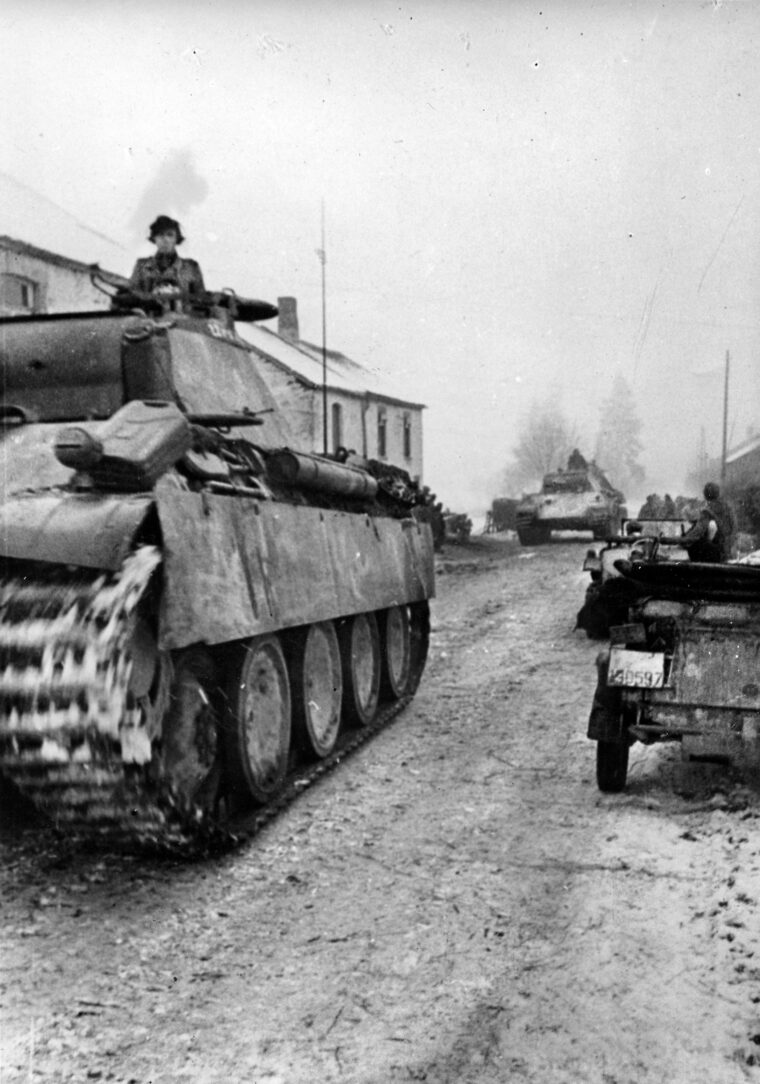
With the bridges in place, two Panther tanks crossed over and engaged Lieutenant Payne’s tanks. These forced the American tanks to seek shelter within the town. The infantrymen were also forced back. To speed his lagging assault, General Kokott now brought up more assault troops, sending Replacement Training Battalion 26 into the battle. With these he made one more effort to drive the Americans out of Hosingen. The effort managed to get some German infantry into the northern fringes of the town, but there they were halted by a fierce American defense.
With their intended path to Bastogne blocked, the Germans now tried a new route through some woods southeast of town, but this was still in view of the Americans, who fired on them. U.S. machine gunners picked off individual Germans as they attempted to dash across the road from the woods. This action continued all night, as the men of Company K felt the Germans moving closer and enemy fire increasing. Their position in Hosingen blocked all approaches to the crossroads at Bastogne from the east, north and south.
Supported by Battery C, 109th Field Artillery Battalion and Lieutenant Payne’s tank platoon, the defenders of Hosingen blocked the 77th Volksgrenadier Regiment’s attempt to cross the Clerf River. Not only that, but the 39th Volksgrenadier Regiment, which was supposed to have bypassed resistance, was somehow drawn into the battle and was making no headway either. Once again, more help was called for by the attacking force. Hosingen had to be taken quickly or the German timetable would be irretrievably disrupted.
A call went out to the Armored Reconnaissance Battalion of Panzer Lehr. Stalled by the obstacle at Hosingen, the exploitation forces could not move and remained bogged down in the mud and winding roads of the Ardennes. German artillery fire renewed its pounding the next morning, knocking out several engineer trucks. A renewed attack was again beaten off, with the American tanks firing directly into the ranks of the German infantry. But the Germans were not to be denied. They had by now surrounded the town on three sides and attacked from them all.
After a two-hour battle, the Americans were forced into the northern part of town amid burning trucks and houses. By dark on December 17, ammunition was running low and artillery support could no longer be employed. Although the Sherman tanks kept the German armor from entering the town, the ammunition supply became critical. Major Milton was advised of the situation, “Town completely surrounded with enemy tanks and infantry. Running low on ammunition. Awaiting further orders.”
Major Milton had earlier been advised by General Cota that reinforcements were on the way to Hosingen. General Cota insisted that the town be held even as late as the morning of December 18, but he then realized that there was no way the reinforcements could break through the German ring surrounding Hosingen. Major Milton had originally hoped that the garrison could break up into small groups and evade capture, but by December 18 that was no longer possible. He contacted Captain Feiker of Company K and left the final decision up to him. The reply was, “We can’t get out, but these Krauts are going to pay a stiff price if they try to get in.”
Over the next few hours the Company K perimeter grew smaller and smaller in house-to-house fighting. A final radio message came late that day stating, “We’ve blown up everything there is to blow up except the radio and it goes next. I don’t mind dying and I don’t mind taking a beating, but I’ll be damned if we will give up to these bastards.” Nothing further was heard from the defenders of Hosingen. Losses were later tabulated at seven killed, 10 wounded, and one missing. Eight officers and 300 men were marched into captivity.
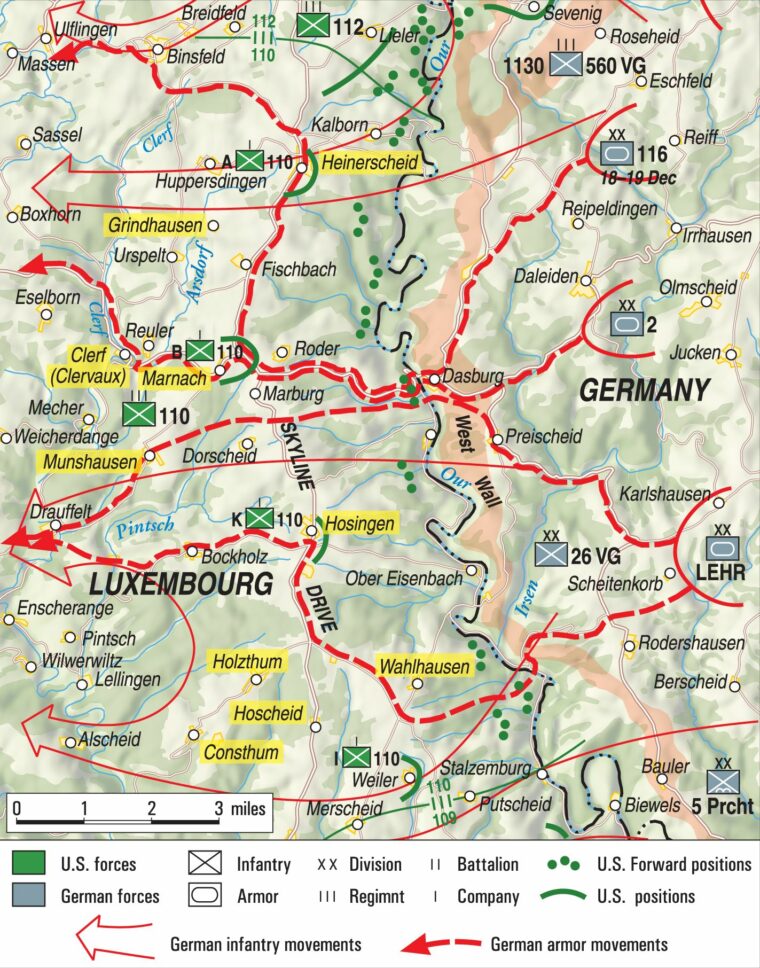
The 1st Battalion, 110th Infantry, had its main defenses at Marncah, which blocked the road to Clerf and Bastogne. The German High Command had designated this road as the main thrust for the vital crossroads town. The 2nd Panzer Division was to push the defenders aside and race to Bastogne. The 28th Panzer Engineer Battalion and the 2nd Battalion, 304th Panzergrenadier Regiment, crossed the Our River in rubber boats before dawn on December 16. Behind them, engineers rushed to complete bridges across the river for the armor to follow. An American minefield delayed the advance for a moment, but by early morning the Germans were approaching Marnach. There they met with resistance from Company B, 110th Infantry, and a reconnaissance platoon of the 630th Tank Destroyer Battalion. Despite being under fire from the attacking infantry and their supporting artillery across the Our River, the defenders gave the Germans a warm reception.
Soon Marnach was surrounded by an estimated 300 German soldiers. Lieutenant Carson, commanding Company B, called down artillery fire on these approaching enemy troops. When Lieutenant Carson was wounded, Colonel Paul sent his own battalion executive officer, Captain J. H. Burns, to take command in Marnach. Meanwhile, Colonel Paul’s repeated efforts to send reinforcements to the surrounded infantrymen in Marnach were foiled time after time by German units advancing past the besieged town.
Colonel Fuller then dispatched two platoons of Company A, 707th Tank Battalion to the rescue, along with Companies A and C of the 1st Battalion, 110th Infantry. A series of confusing moves and firefights ensued with little change in the situation. So confused was the battle that in one instance an M16 halftrack of the 447th Antiaircraft Artillery (Automatic Weapons) Battalion was guarding a crossroads when a column of Germans marched toward it. Upon seeing the vehicle, the German column paused. A fast-thinking GI waved the Germans forward. When they resumed their march, the heavy .50-caliber machine guns killed over 100 of the enemy.
At division headquarters, General Cota was trying to aid the hard pressed 110th Infantry. His reserves were limited to the 2nd Battalion, 110th Infantry, and most of the 707th Tank Battalion. Aware by now that the entire VIII Corps was under a major attack, he knew that his 28th Infantry Division was on its own for the foreseeable future. The worst situation was clearly the front of Colonel Fuller’s command, and so he ordered Companies A and B of the 707th Tank Battalion to reinforce the 110th Infantry. These units were sent to Hosingen and Marnach with mixed success. Despite Colonel Fuller’s pleas for the return of his 2nd Battalion, General Cota refused at this time.
But time and German aggressiveness were against the “Bloody Bucket.” Ammunition supplies were rapidly becoming exhausted, and the short winter days promised to allow the Germans to use the cover of night to surround the individual American strongpoints along the front line. Soon the bridges the German engineers were struggling with across the Our River would be completed, and then the situation would get much worse. One tank platoon did reach Marnach, but only after missing in the confusion Company C, which they were supposed to escort into that besieged town. At Marnach, the Germans soon had tank support which struck at the town just before darkness fell. The last message from Colonel Paul was, “German tanks are just going on to enter Marnach.”
At his regimental headquarters in the Clerf Hotel, Colonel Fuller prepared for a last-ditch defense of that critical town. The town happened to be a rest center for the division, and with General Cota’s permission Colonel Fuller rounded up about 300 officers and men, armed them with rifles, carbines and grenades and organized them into provisional platoons under Lieutenant Johnston of the 110th Infantry. These men were placed in defensive positions blocking the Clervaux-Marnach Road to the east of Clerf. In support was a platoon of heavy machine guns from Company D and a 2nd Battalion platoon of antitank guns. Cooks, clerks, Special Service men and other administrative personnel were sent into the local castle with orders to turn it into a strongpoint. Soon, German artillery shells were falling on Clerf with alarming regularity.
That evening General Cota advised Colonel Fuller that he was returning his 2nd Battalion to him. He also ordered all his regimental commanders, including Colonel Fuller, to “Hold at all costs.” Colonel Fuller replied that he would use the 2nd Battalion to counterattack to regain possession of Marnach. If that attack was successful, he would continue it to recover all the lost strongpoints along Skyline Drive. General Cota approved of his plan and released the 2nd Battalion, 110th Infantry, to Colonel Fuller, less Company G, which he retained for his own headquarters defense at the town of Wiltz. Colonel Fuller planned for his 2nd Battalion, less Company G, and Company D (light tanks) of the 707th Tank Battalion to attack in the morning along Skyline Drive toward Marnach. He also ordered the 1st Platoon of Company A, 707th Tank Battalion, and his own Company C, to attack that objective at the same time.
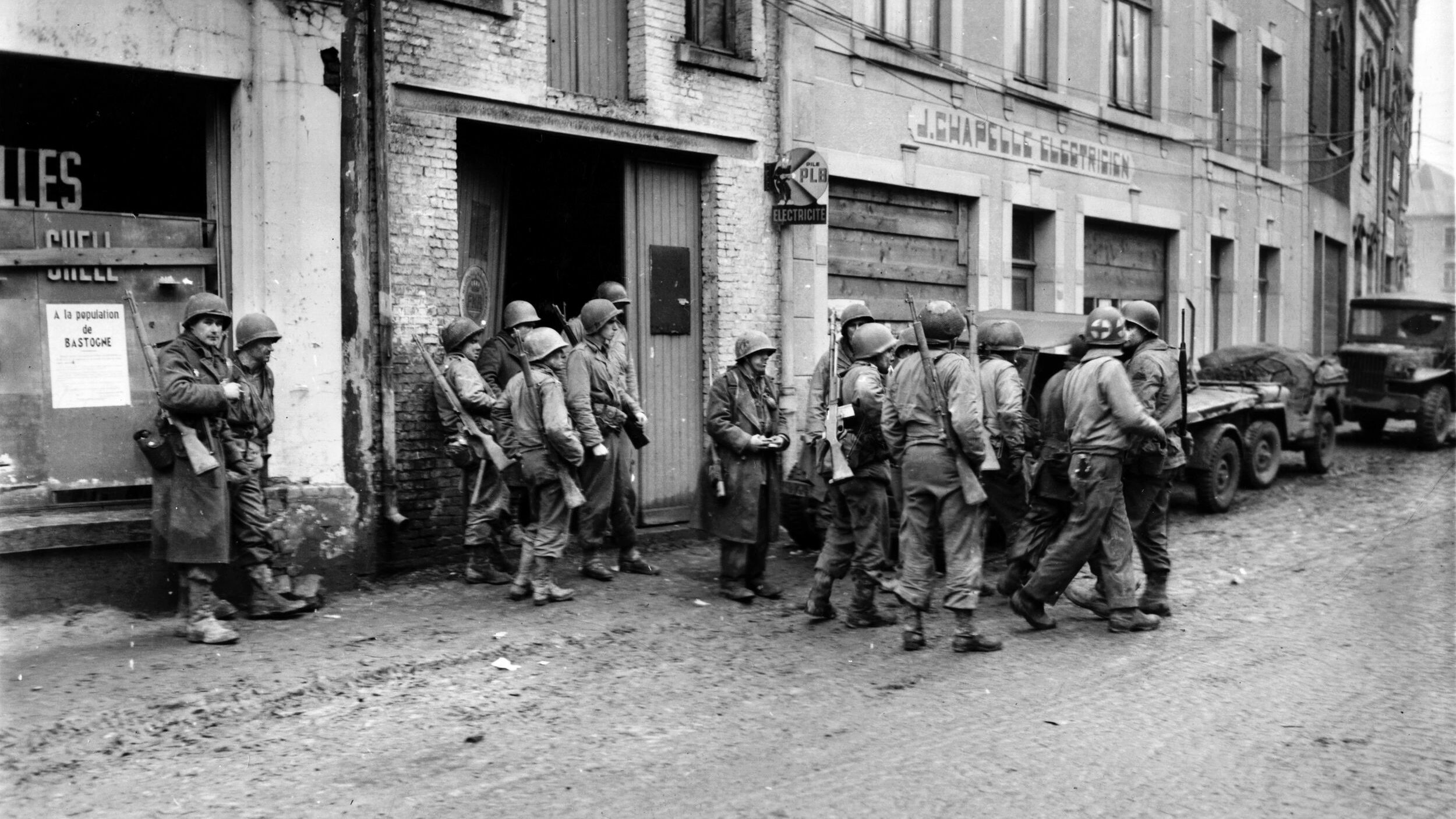
Colonel Fuller’s plans were offset by the German’s success in finally bridging the Our River. Tanks, assault guns and heavy weapons finally began to reach the advanced infantry formations facing the American strongpoints along Skyline Drive and elsewhere. Contact had been made with the German 5th Parachute Division, which had been busy separating the 109th and 110th Infantry Regiments from each other
The opening day of the offensive had not gone as planned for the Germans. The American infantry had held their ground, using excellent defensive positions and their artillery to block German advances where they did not have infantry coverage. Despite overwhelming odds in many cases, the GIs had not yielded to enemy pressure and held their positions until forced back by casualties and lack of ammunition. When pushed back, they had destroyed everything of value to the Germans, blocking roads, laying minefields, and delaying the enemy far longer than was expected. Nowhere had the Germans gained their objectives. General Luettwitz was not pleased with the day’s results.
Like General Cota, Major General Troy H. Middleton, commanding VIII Corps, also issued a hold fast order to all his commands. Under no conditions were any of his troops to withdraw until their positions were “completely untenable.” No one was to retreat beyond a specified line issued by VIII Corps. In the case of the 110th Infantry, this line had already been breached by the 2nd Panzer Division at Marnach.
At Clerf things began to go wrong early in the morning hours of December 17. As German artillery quieted down, infiltrators with automatic weapons began to appear on the outskirts of town. Soon they were engaged with the administrative troops in the castle. With dawn came a single tank or self-propelled gun firing into the town. More enemy infantry appeared and joined the battle. Then with full daylight came two platoons of German Mark IV tanks and 30 half-tracks carrying infantry. The 2nd Platoon, Company A, 707th Tank Battalion, moved out of Clerf to engage the enemy tanks. Four enemy tanks were destroyed against three American losses. Company A’s 1st Platoon also moved up along with some infantry and reinforced Clerf. Enemy tanks engaged them but ceased when the American tanks knocked out the German lead vehicle. Other German tanks stood off on nearby ridges and pounded the town with their heavy guns.
About this time, General Middleton sent some assistance from Combat Command Reserve (CCR) of the 9th Armored Division. Originally intended to back up the 28th Infantry Division’s center, General Cota appropriated Company B, 2nd Tank Battalion to directly support the 110th Infantry. When the 19 tanks arrived at Clerf, Colonel Fuller sent one platoon to clear the Germans out of the south end of town, another to help the 2nd Battalion’s attack, and the third to Heinerscheid where the light tanks of the 707th tank Battalion had been smashed the day before.
Despite this help, the 2nd Battalion’s attack was pushed back by more and more German armor. The newly arrived armored force was being steadily eroded by this increasingly strong enemy attack. Company B, 630th Tank Destroyer Battalion, was down to its last remaining vehicles. Pushed back to regimental headquarters, Companies E and F dug in on a ridge just ahead of Clerf to defend that town. With the ongoing losses, the battalion’s flanks were soon uncovered, and a small column of German tanks entered Clerf from the south.
At 6:25 that evening, Colonel Fuller advised division headquarters that his command post was under direct German fire and that enemy tanks were roaming through the town. Colonel Fuller and his staff escaped, hoping to join Company G, recently released by General Cota, and reportedly approaching Clerf from the west. But Colonel Fuller was soon captured and his staff dispersed.
The battle for Clerf did not end with Colonel Fuller’s capture, however. In the castle, or chateau, manned by the administrative men of the regiment and other units, the battle continued. The 3rd Panzer Regiment had assembled in the town, and for some hours they ignored the Americans in the chateau. Maybe they were busy looting the American supply depots or just getting some rest. Yet, as late as 5:30 on the morning of December 18 the little group made radio contact with the 28th Infantry Division and reported themselves still in position, holding off German probing attacks. But this was not to last.
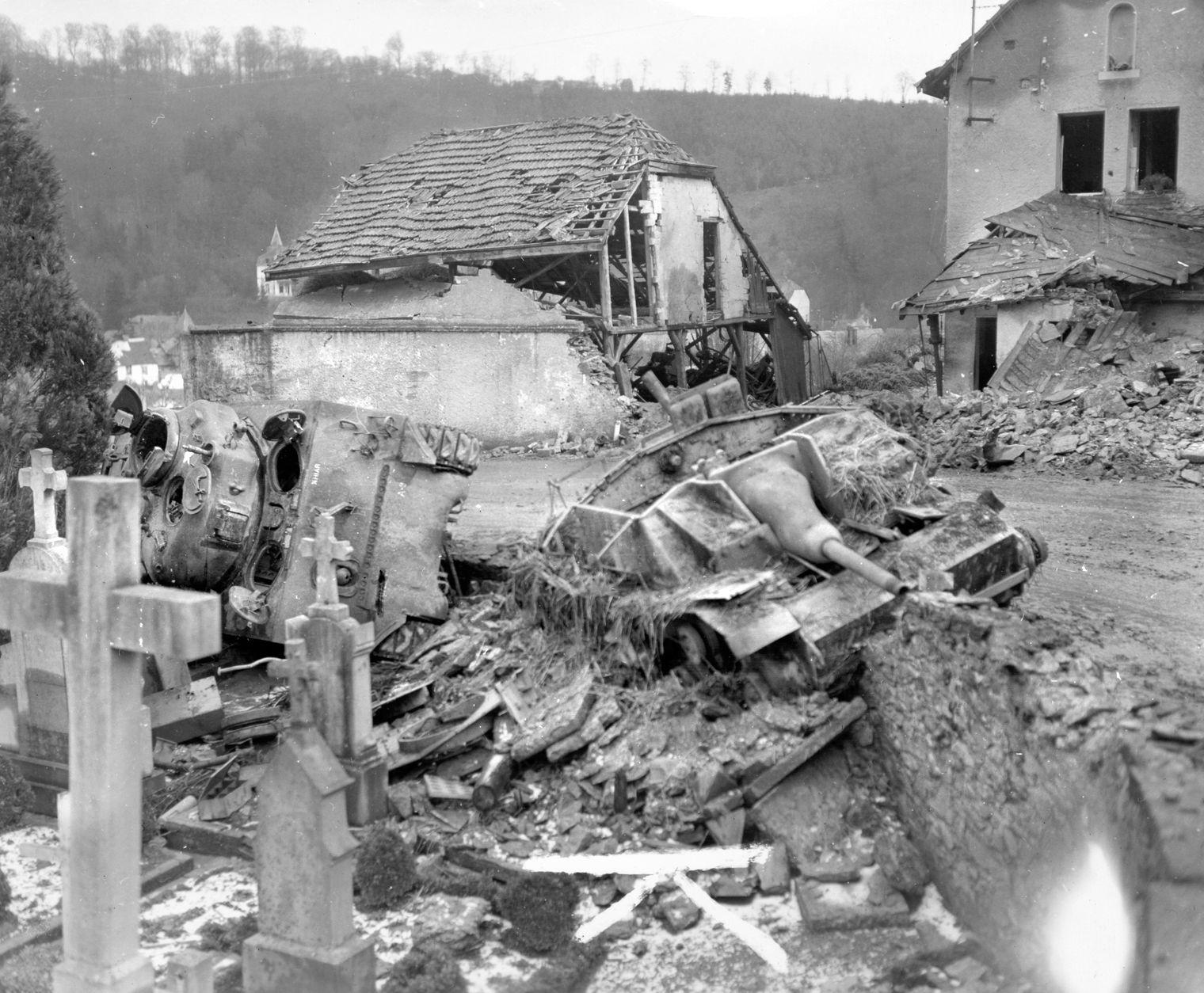
At dawn on December 18 the Panther Battalion of the 3rd Panzer Regiment rolled into Clerf. They, too, ignored the annoying Americans in the castle. Their bullets and grenades were harmless to the big tanks, but they did serious damage to their own German infantry as they passed through town, causing yet more delays. Clearly, they would have to be eliminated. German engineers and self-propelled 88mm guns were brought up for direct assaults on the castle, which was holed repeatedly. After several hours of fierce combat, the surviving Americans were forced to surrender. What was left of the 110th Infantry was then finally withdrawn for rest and reorganization.
The last recorded fighting by the 110th Infantry occurred at the village of Consthum, where the regiment’s executive officer, Lieutenant Colonel Daniel Strickler, and portions of the 3rd Battalion, with three tanks and a few vehicles of the 447th Antiaircraft (AAA) Battalion, held out until the afternoon of December 18 before a heavy fog allowed the Germans to enter the town. But that same fog and smoke from the battle allowed the battalion to evacuate the town and eventually, after several additional adventures, reach safety.
The cost of holding the Ardennes to the 110th Infantry has never been officially calculated. The best estimate by the Army’s historian of the battle gives casualties at 2,750 officers and enlisted men. The survivors, mostly Company G, Company C, and the 3rd Battalion, with many stragglers of other units of the regiment, withdrew behind the lines of the 9th Armored Division.
On December 16, 1944, the 110th Infantry Regiment held a front line 20 miles long on the direct route from Germany’s Westwall defenses to Bastogne. It was there recovering from massive losses from the earlier battle in the Hürtgen Forest. Without warning from intelligence sources, it became the focus of the major thrust of the massive German winter counteroffensive intended to reach Antwerp. With too few troops to form any kind of defense in depth, the “Bloody Bucket” division was forced by circumstances to resort to a strongpoint defense in local villages along their front. Fortunately, this system of all-around defense proved successful when the division was struck by five German divisions and fought for three days (December 16-18) in villages, towns, buildings, roads and crossroads to hold back this attack,in accordance with their orders to hold at all costs.
The costs were high, resulting in an estimated loss of two-thirds of the 110th Infantry Regiment in those three days. The other regiments suffered equally, but together the 28th Infantry Division disrupted the German timetable while the American high command gathered reserves, garrisoned Bastogne, and formed a counteroffensive of its own.
The 110th’s effort was recognized even by the enemy commander, General Hasso von Manteuffel, who wrote, “The Clerf was not reached at any point. The enemy [28th Infantry Division] was unquestionably surprised by the attack. He offered, however, in many places tenacious and brave resistance in delaying by skillfully fought combat tactics…the tenacious resistance of the enemy, together with the road blocks placed…were the most essential reasons for the slowing of the attack whose time was not going according to plan.”
For its gallant stand along Skyline Drive and elsewhere those cold December days, the 28th Infantry Division received no recognition from its own government. The government of Luxembourg awarded it the Croix de Guerre, and the 112th Infantry Regiment received a Presidential Unit Citation, but that was the extent of the official recognition. But perhaps that was all that was needed, for the men of the “Bloody Bucket” know what they did, what it cost, and how important it was.
Nathan Prefer is the author of numerous books and articles on World War II. He received his Ph.D. in military history from the City University of New York and is a former Marine Corps reservist. Dr. Prefer is now retired and resides in Fort Myers, Florida.
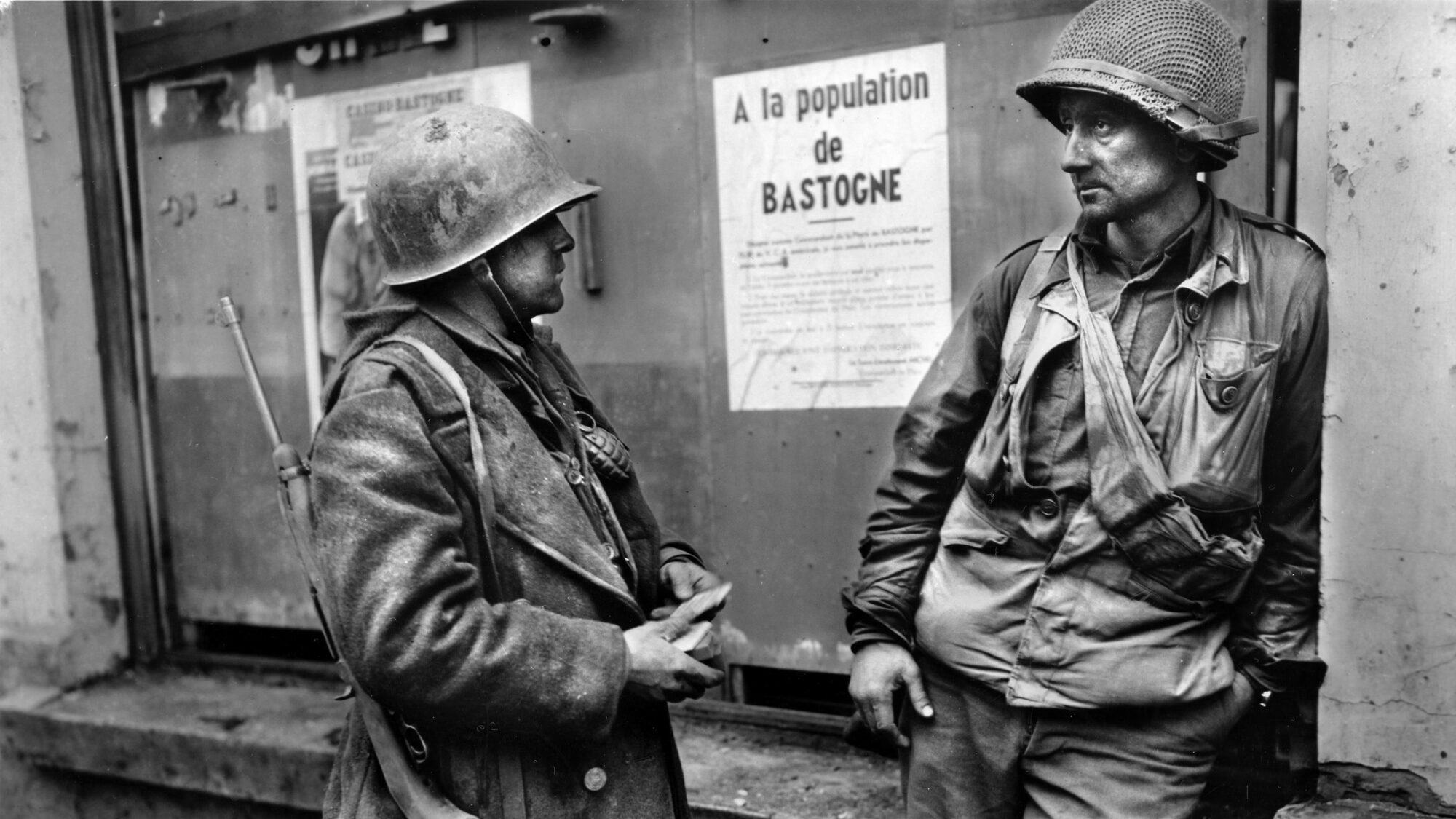
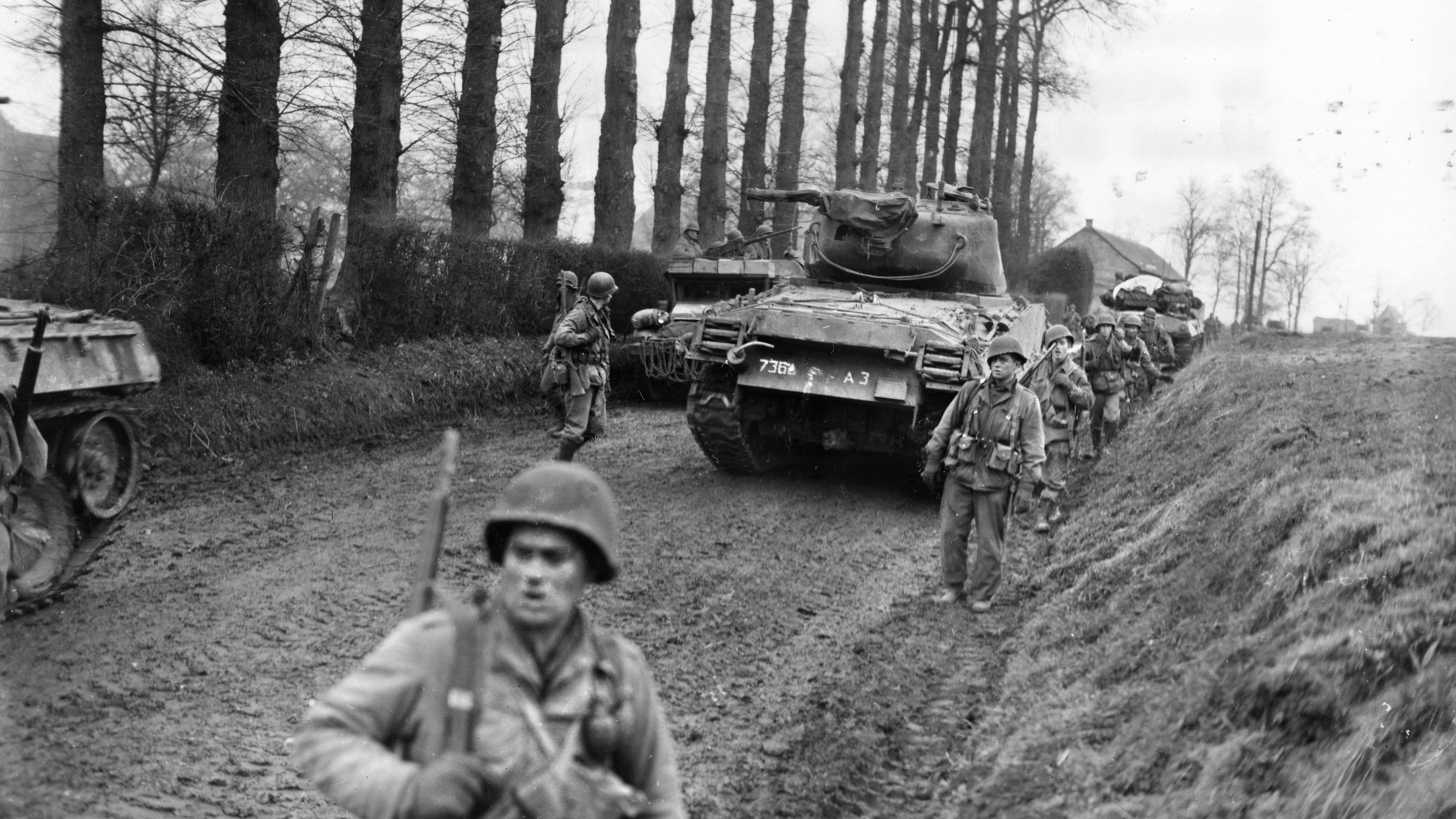
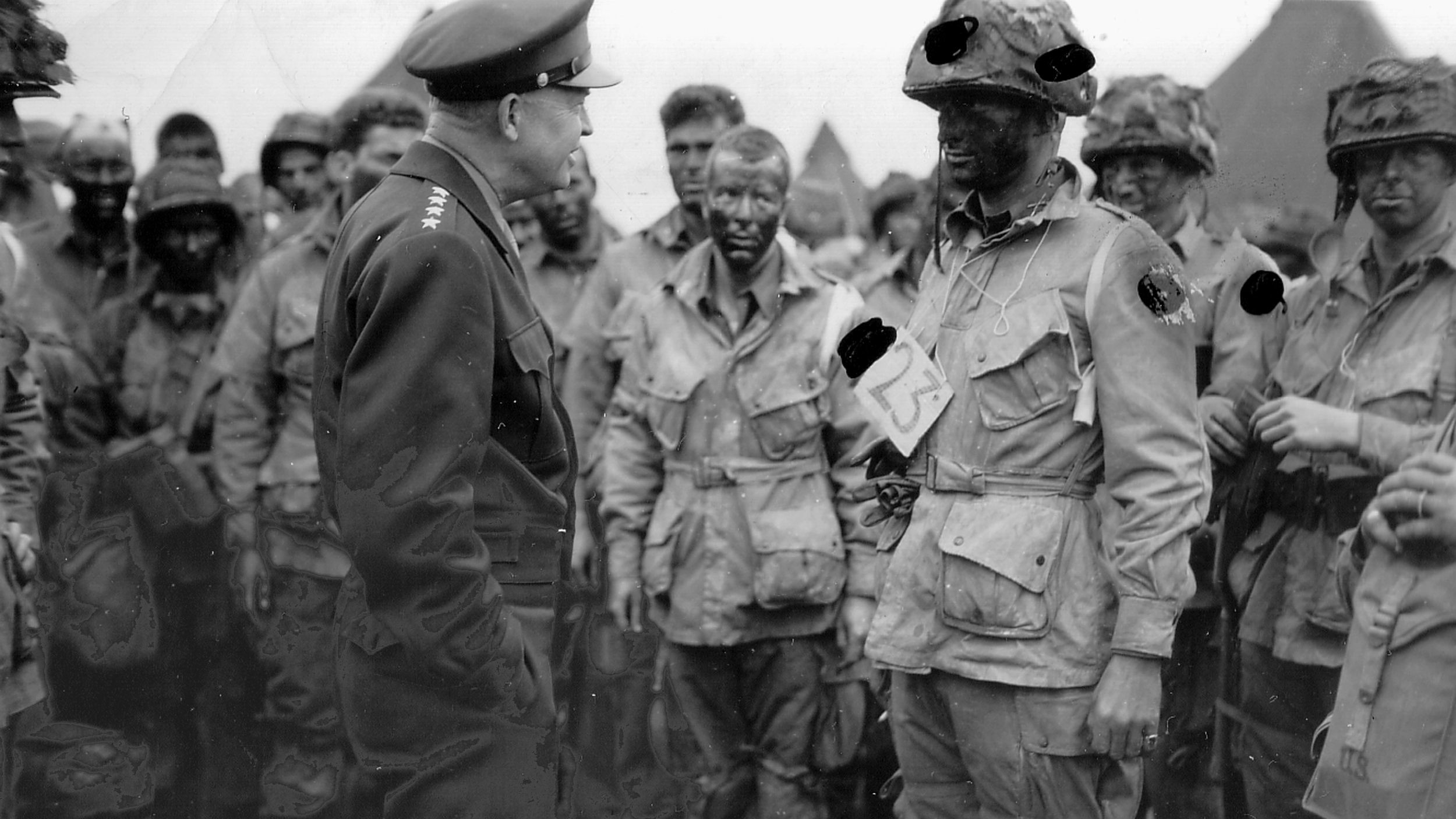
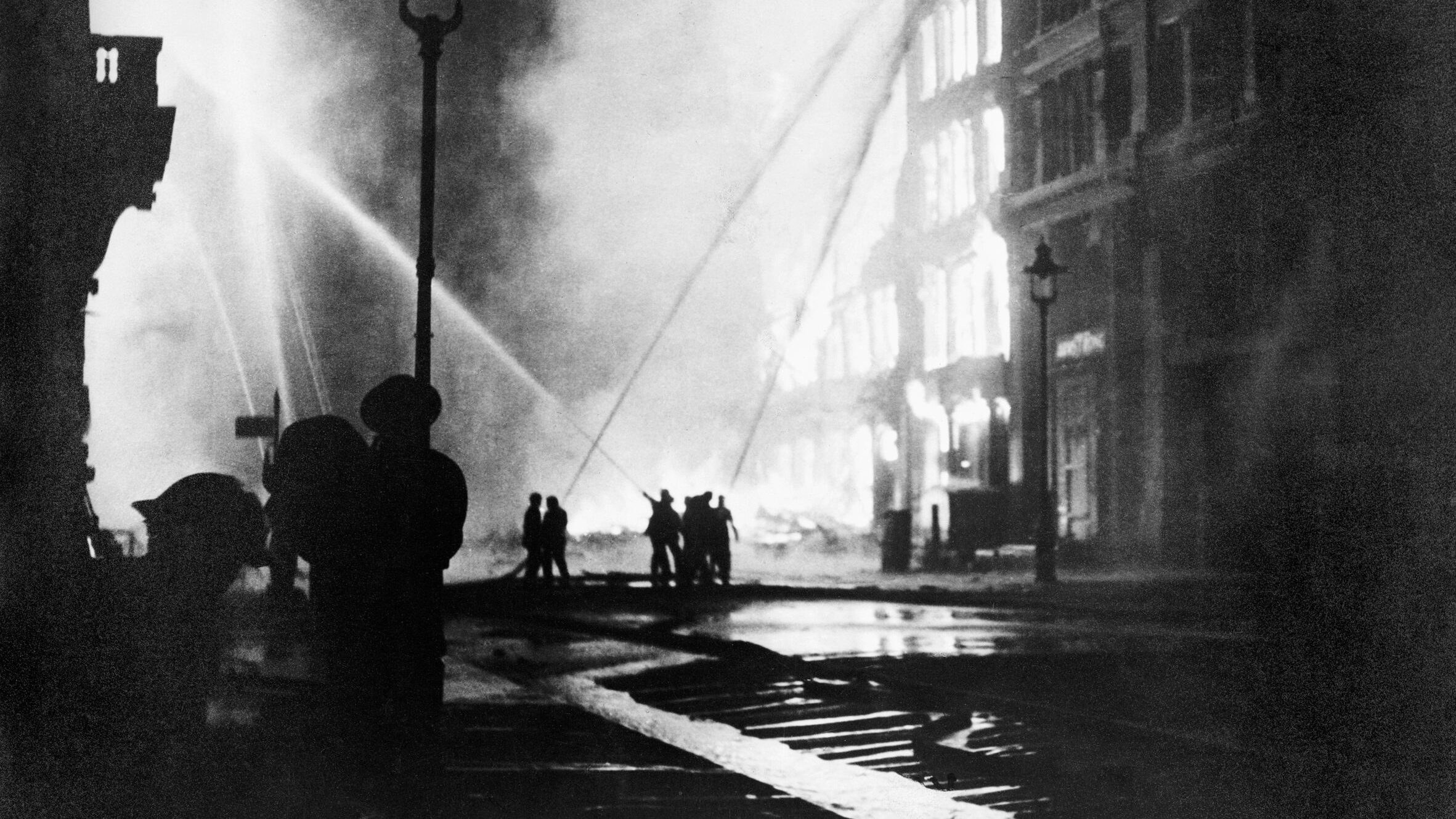
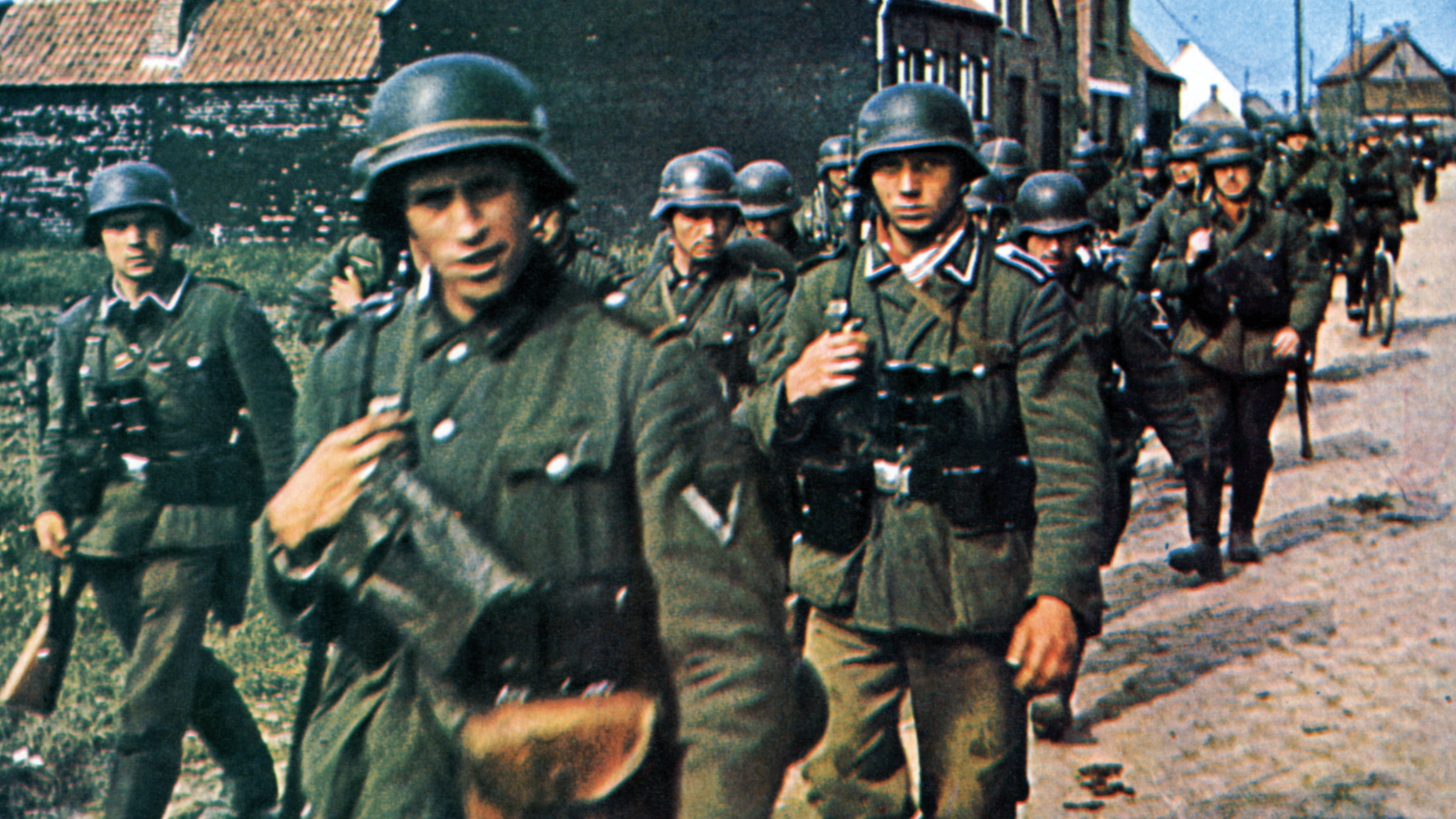
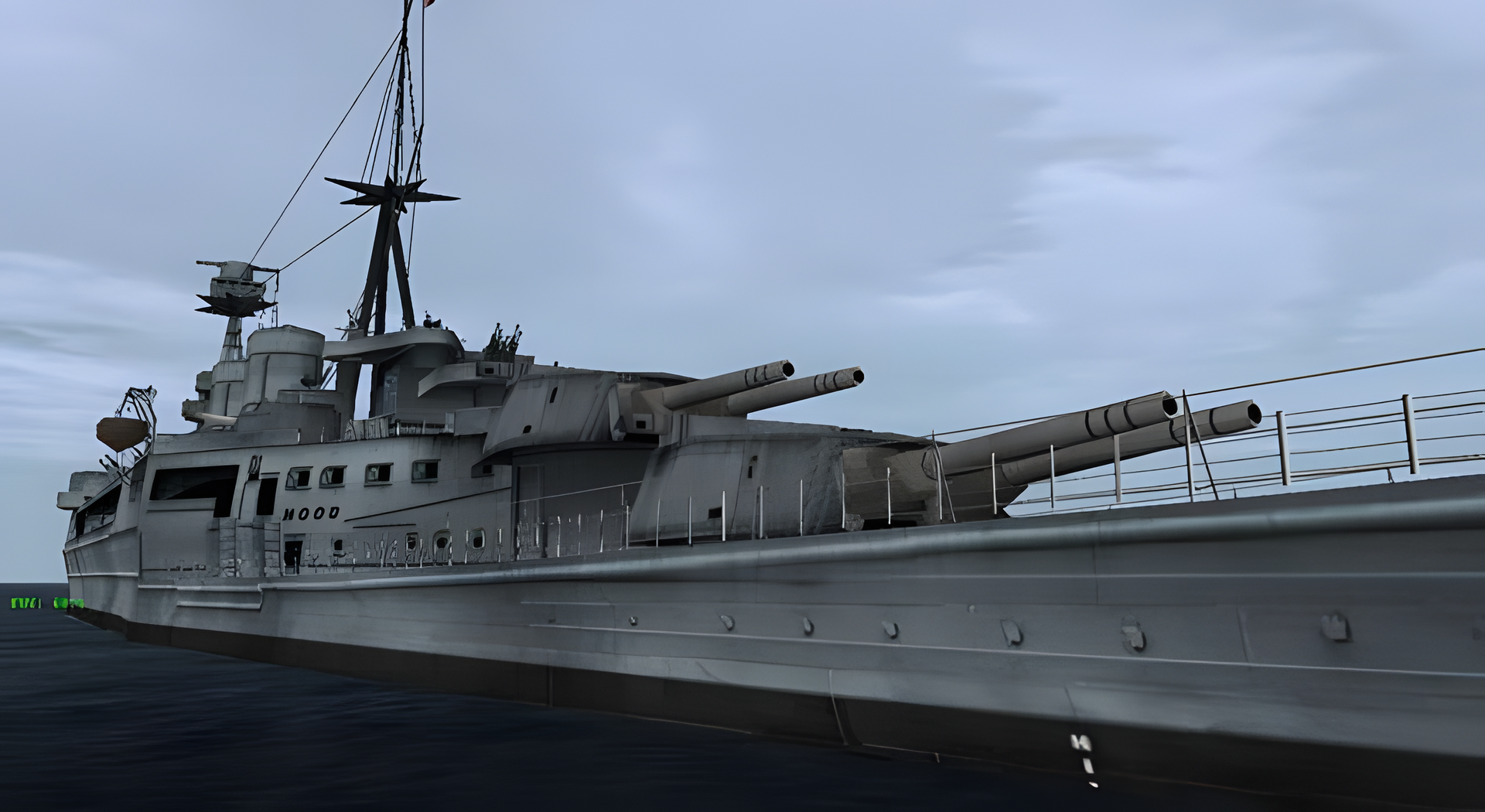
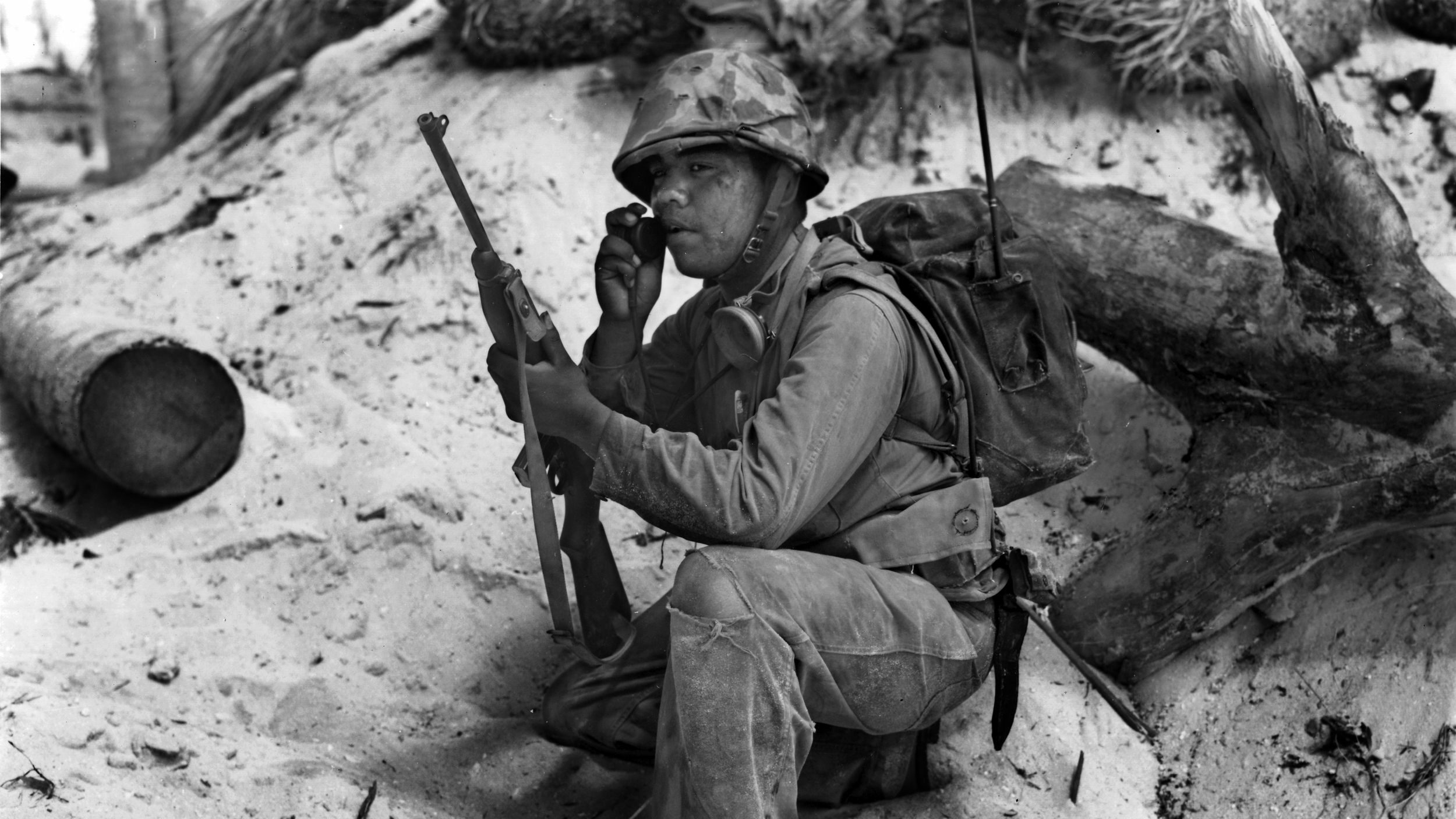
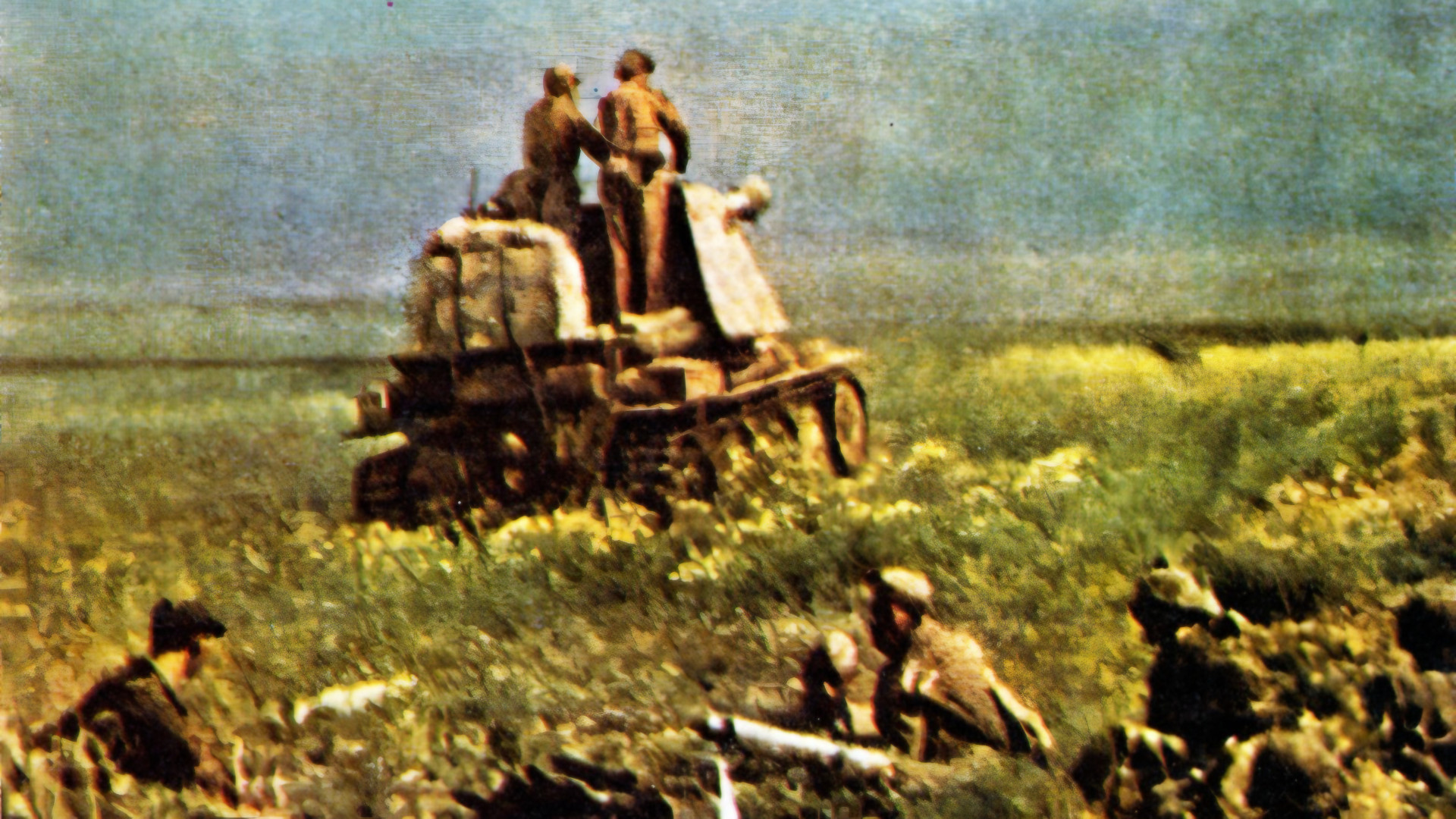
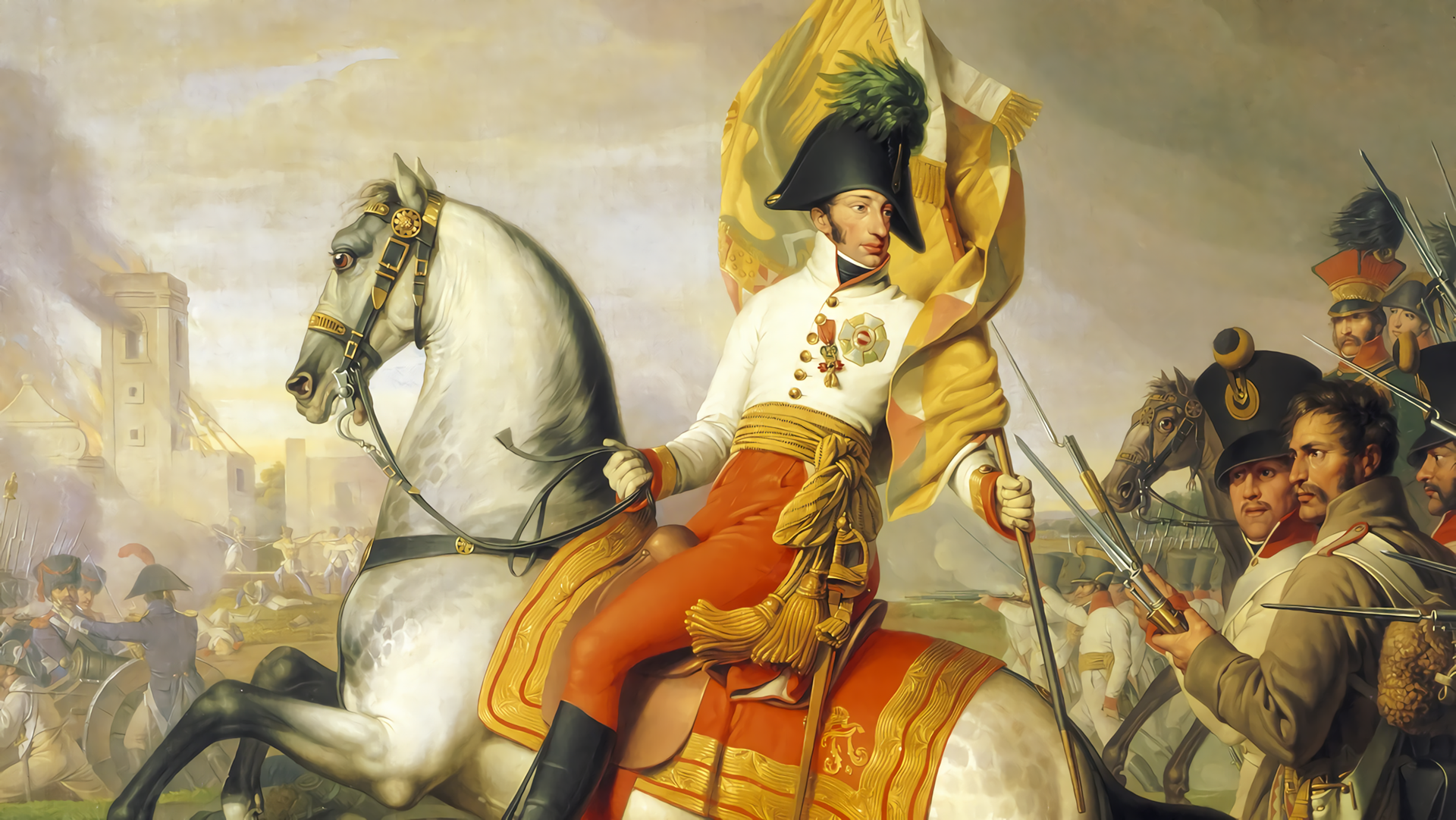
Join The Conversation
Comments
View All Comments